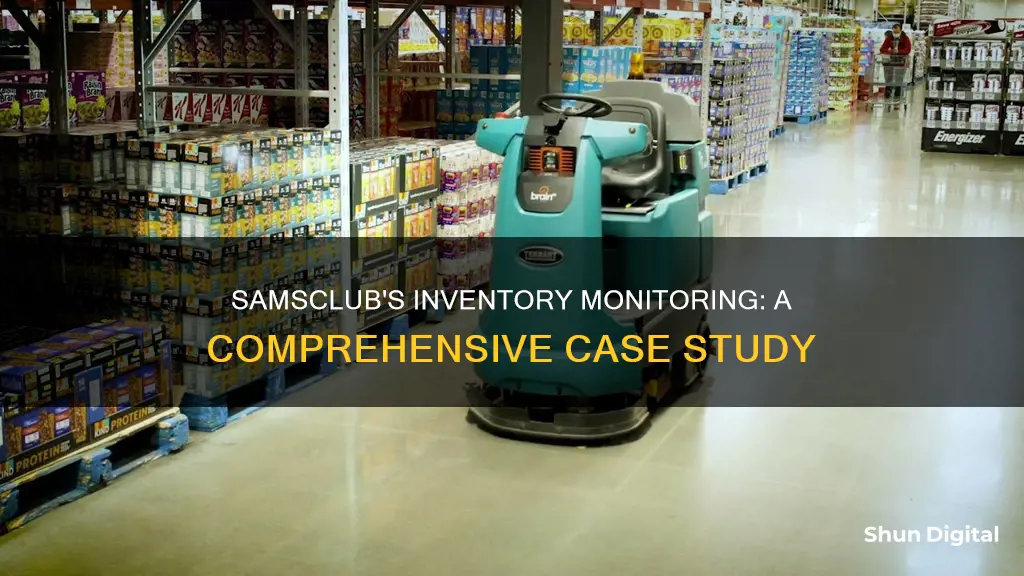
Sam's Club is a member-only retail warehouse with 597 clubs and supply chain facilities across the US and Puerto Rico. Senior Director of Facilities Maintenance, RJ Zanes, is responsible for overseeing the facilities maintenance strategy for all of Sam's Clubs' locations. To achieve this, Zanes needed to attain 100% uptime for every asset in a cost-effective way, tagging all assets, driving real-time system reliability, and developing KPIs for each asset. By leveraging data, Zanes has been able to accelerate decision-making and take a more strategic approach to managing the lifecycle of assets.
| Characteristics | Values |
|---|---|
| Nature of Business | Member-only retail giant |
| Goal | To be the world's most reliable, sustainable real estate platform |
| Number of Operating Clubs | 597 |
| Areas of Operation | US and Puerto Rico |
| Approach | Technology-first |
What You'll Learn

Data-driven decision-making
To achieve this, Sam's Club partnered with ServiceChannel to implement a data-driven maintenance platform that enables efficient tracking, planning, and predicting of asset needs. This platform collects and houses information on all serialized assets, providing real-time updates to RJ's team. This data accessibility accelerates decision-making and enables a strategic approach to asset lifecycle management, including optimising uptime and total cost of ownership.
By tagging all assets with make, model, and serial number, Sam's Club can effectively measure uptime for each asset. Additionally, they drive system reliability by leveraging a 24/7 call centre, work order management, and a provider network. The use of Scout, a free service included with ServiceChannel subscriptions, helps identify provider upgrades that can reduce costs and downtime.
The data-driven approach has resulted in significant benefits for Sam's Club. Firstly, it has achieved 100% uptime for assets in every location while also optimising costs. Secondly, the ability to pinpoint investments in specific assets has improved operational efficiency, cost control, and reporting. Lastly, the use of data has led to an increase in first-time completion rates, ensuring a consistent and delightful experience for members.
In conclusion, Sam's Club's data-driven decision-making, supported by ServiceChannel's platform, has been instrumental in achieving their goal of providing reliable and delightful experiences to their members while optimising costs and operational efficiency.
Asus 28-inch Monitor: Surprisingly Light and Portable
You may want to see also

Cost-effective asset management
Strategies for Cost-Effective Asset Management:
Data-Driven Decisions:
Sam's Club leverages data to make informed decisions about its assets. By using a data-driven maintenance platform, they can track, plan, and predict the needs of each asset, ensuring they are operating efficiently and effectively. This data helps them identify the optimal uptime state and total cost of ownership for each asset.
Asset Tagging:
Tagging assets with make, model, and serial number is a foundational step in effective asset management. This allows Sam's Club to measure uptime on each asset and quickly access relevant information. With all serialized assets tagged, they can now receive real-time updates on any asset, helping them make timely decisions and take prompt actions.
Provider Optimization:
By using Scout, a provider optimization tool, Sam's Club can identify the top providers who offer the best value in each region and trade. This helps them reduce costs and improve first-time completion rates, ensuring that maintenance and repairs are done right the first time.
Technology-First Approach:
RJ Zanes, Senior Director of Facilities Maintenance, has implemented a technology-first approach to asset management. This includes using digital tools like ServiceChannel's Asset Manager to streamline information and make it easily accessible. This approach has helped them attain their goal of 100% uptime for assets across all locations in a cost-effective manner.
Condition-Based Monitoring:
Condition-based monitoring is a critical aspect of Sam's Club's asset management strategy. By regularly monitoring the condition of their assets, they can identify potential issues and take preventive measures. This helps extend the lifespan of assets, reduce unexpected breakdowns, and lower maintenance costs over time.
By implementing these strategies, Sam's Club has been able to achieve cost-effective asset management while maintaining high standards for their members' shopping experiences.
Understanding Monitor Dimensions: A Simple Guide to Measurements
You may want to see also

Real-time updates
The Asset Manager tool within the ServiceChannel platform plays a pivotal role in providing real-time updates. This tool allows the facilities maintenance team to tag all assets with their make, model, and serial number, facilitating accurate tracking and monitoring. With this detailed asset information, the team can make data-driven decisions and optimize their maintenance strategies.
The ability to receive real-time updates has significantly improved operational efficiency and cost control. For instance, the team can quickly identify and address any issues with specific assets, minimizing downtime and reducing maintenance costs. Moreover, real-time updates enable better insights and reporting, allowing Sam's Club to pinpoint investments in specific assets and make more informed decisions to enhance the member experience.
To further enhance the effectiveness of real-time updates, Sam's Club utilizes a 24/7 call center, work order management systems, and a provider network. This comprehensive approach ensures that any maintenance issues or requests are promptly addressed, and the appropriate providers are dispatched without delay. As a result, Sam's Club can maintain its commitment to delivering a consistent, neat, clean, and delightful shopping experience for its members.
In conclusion, real-time updates are a critical component of Sam's Club's inventory management strategy. By leveraging technology and data, the company can make more informed decisions, optimize asset performance, and ultimately, provide a superior level of service to its members. This technology-first approach positions Sam's Club as a leader in the industry and sets a standard for others to follow.
GPS Ankle Monitors: Cancer Risk or Safe Surveillance?
You may want to see also

Lifecycle asset management strategy
A lifecycle asset management strategy is a fundamental part of any business operation. This strategy involves the management of asset health and productivity across several stages, with the goal of keeping assets running smoothly throughout their lifespan.
There are six main stages of asset lifecycle management: planning, valuation, procurement and installation, utilization, maintenance, and decommissioning/disposal.
In the first stage, planning, stakeholders assess the need for the asset, its projected value and overall cost to the organization. This includes considering the risks associated with the acquisition, such as the likelihood of technological advancements that could make the asset redundant, the potential for failure or replacement, and the availability of resources needed to operate the asset.
The second stage, valuation, involves carefully assessing the overall value of the asset. This includes considering the asset's likely lifespan, projected performance over time, and the cost of disposing of it. A technique that is becoming increasingly valuable during this stage is the creation of a digital twin, a virtual representation of the asset that allows operators to run tests and make predictions based on simulations.
The third stage is procurement and installation, which involves purchasing, transporting, and installing the asset. Operators must consider how the asset will perform within the overall ecosystem of the business, how its data will be shared and incorporated into business decisions, and how it will be integrated with other assets.
The utilization phase is critical to maximizing asset performance and extending its lifespan. This is where predictive and preventive maintenance strategies are implemented to keep assets running longer and generating more value.
Maintenance is an ongoing process that focuses on extending the asset's useful life, maximizing productivity, and keeping costs low. This stage involves regular inspections, cleaning, and lubrication, as well as the replacement of certain components on a set schedule.
The final stage is decommissioning/disposal, which occurs when the long-term value of the asset no longer justifies the cost of maintaining it. This stage involves considering the depreciation of the asset, the rising costs of maintenance, and calculating the overall return on investment.
By implementing a comprehensive lifecycle asset management strategy, organizations can maximize their return on investment in their assets, reduce costs and downtime, improve operational efficiency, and ensure compliance with relevant laws and regulations.
Buying Guide: 3D Monitors with Glasses
You may want to see also

Provider optimisation
To optimise its providers, Sam's Club uses Scout, a free service included with ServiceChannel subscriptions. Scout allows customers to identify which provider upgrades will have the most significant impact on reducing costs and downtime. By using Scout, Sam's Club was able to achieve annual savings by replacing just three providers in three markets.
The company's senior director of facilities maintenance, RJ Zanes, emphasised the importance of understanding the conditions of all assets to ensure a consistent and delightful shopping experience for members. This understanding enables the company to pinpoint investments in specific assets.
By leveraging data, Sam's Club has been able to accelerate decision-making and take a more strategic approach to managing the lifecycle of its assets. This includes knowing the optimal uptime state for each asset and the total cost of ownership.
The use of technology has been instrumental in helping Sam's Club attain its goal of 100% uptime for assets in every location while also controlling costs. The ServiceChannel platform plays a crucial role in this, as it collects and houses all the information for Sam's Club, providing real-time updates on any asset at any location. This enables the company to make informed decisions and optimise its provider network.
Best Places for Cheap Monitors in Sacramento
You may want to see also







